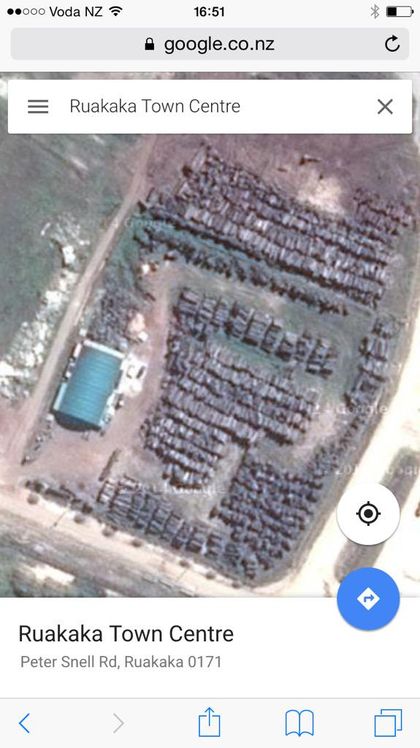For the purposes of profiteering, when is a kauri stump not a stump? According to Section Two of the Forest Act of 1949, it’s when there’s more trunk than stump: that’s to say the section of sawn timber cannot be longer than the base of the tree was wide. These semantics define the very legality of Northland’s “black gold rush” – the disinterment of long-buried kauri logs.
For instance, when sawn lengths of swamp kauri are offered for sale on the website of Wisconsin-based furniture company Ancientwood that measure 12 metres in length, it means that, assuming someone has followed the letter of the law, they have exported timber from a tree more than twice the width of Te Matua Ngahere, the widest known living kauri at 5.2 metres across.
OK; so when is a table not a table? Under the Act, sawn indigenous swamp timber can be exported if it is deemed to be a “finished product.” For companies cashing in on the buried boom, that means rough-sawn slabs are, to all intents and purposes, table tops – after all, the Ministry of Primary Industries (MPI), which is responsible for scrutinising these exports, does not consider that a table should have legs.
Round logs? No sir, those there are ‘temple poles’. What about this giant log with the lines scratched on it? That, you philistine, is a sculpture.
Clearly, a great many swamp kauri exports are a scam, but the Government seems unwilling even to send for a tape measure. The Northland Environmental Protection Society (NEPS) has repeatedly pointed out that MPI’s own records show that it regularly rubber-stamps such improbable transactions.
Primary Industries Minister Nathan Guy insists “They are finished products, I have seen some fantastic-looking kauri swamp logs being carved and they’re going to be an amazing feature for our country and an international country that they’re destined for. So we manage it very, very closely.” Really? Documents obtained under the Official Information Act by the NEPS are claimed to show that in fact, mandatory information was missing from some 80 per cent of MPI intention-to-export notices processed in 2013.
Yet Ancientwood director Robert Teisberg was able to insist to Radio New Zealand this week that the gargantuan slabs of swamp kauri he’s selling for up to US$100,000 a pop are entirely legal, because the export has been approved by MPI. “The exporters have used trickery, successfully duping officialdom while the Minister for Primary Industries, Nathan Guy, insanely suggests there is no loophole,” blustered Winston Peters. “Chiselled scribbles on ancient kauri logs cannot be accepted as artwork and finishing work - these exports are illegal.”
Worse, they’re destroying one of our most vulnerable and depleted ecosystems – peat wetlands. Some “swamp kauri” is actually dug from farmland, but much of it comes from what was once a vast network of wetland systems that stretched across the far north. Most of it was drained, burnt and cleared for farmland, but one of the largest relict stretches survives as the Kaimaumau Swamp, between the Rangaunu Harbour and the Houhora Heads.
The largest protected peat wetland left in Northland, it is – or was – home to a variety of rare and threatened plants such as Thelymitra Ahipara, one of only two native sun orchids, and rare birds such as bittern and marsh crake.
But when NEPS and Northland Forest and Bird staff went looking for sun orchids in Kaimaumau last September, all they found was destruction. Heavy machinery had been digging up the swamp, even though it’s supposedly protected as a scientific reserve. In their hoggish lust for profits, kauri miners have pillaged Kaimaumau and other protected wetlands.
Even swamps on privately-owned land are legally inviolate if they’re home to rare or vulnerable native plants and animals. Such is the critical state of wetland biodiversity nowadays that this realistically means most of them.
Yet miners have posted videos to YouTube showing machinery ripping up wetlands. In 2013, Northland Regional Council brought charges against Raymond Bird and Gary Beckham after they illegally drained a protected swamp in 2010 to get at buried kauri logs. When they were issued with an abatement notice, they simply kept digging, says the Council, ignoring that Environment Court order, and a subsequent one directing them to remediate the damage they’d done.
As he was driving to court to testify against the pair, Council officer Mike Nager was waylaid. His assailant sprayed bleach into his eyes, slashed his face with a knife, punched him to the ground and told him to “stay the fuck away.”
Beckham denied involvement: “I personally think he did it himself.”
In the end, the pair each were fined $50,000 and sentenced to 200 hours community service. But by then Bird’s business, Sovereign Station, had failed, owing creditors more than $5 million. Beckhams’ company, Mangonui Development and Civil Construction, had also closed, owing substantial debts. Bird was on the dole, which means that Northland District Council’s chances of recovering its costs were practically non-existent, even though a single swamp kauri log can be worth twice that fine.
Nathan Guy insists that swamp kauri is an international showcase for New Zealand. All it has demonstrated to the world so far is cynical, venal exploitation – much of it illegal – and feeble, irresolute governance. That the Government appears comfortable to preside over the continuing destruction of our last few wetlands – after the country has already lost more than 90 per cent of them – in the name of rampant racketeering is a side of our national character I doubt the international community finds attractive.
That one of the prominent speculators in this grey market in taonga happens to be David Wong-Tung, husband of National MP Judith Collins, should rightly raise eyebrows, along with suspicions that her involvement places the Government in an awkward spot – again. Wong-Tung is a director in Kauri Ruakaka Ltd, formerly Oravida Kauri, which has stockpiled an estimated 80,000 tonnes of logs.
When I enquired about buying swamp kauri through Chinese commerce site Alibaba, I was quoted US$3950 – NZ$5703 – a cubic metre (cut, incidentally, into six-metre lengths – longer still than any known kauri is wide). The value of Kauri Ruakaka’s holdings of logs has been estimated at $50 million.
Maybe Wong-Tung and his business partner, multi-millionaire Deyi “Stone” Shi, really do intend to build a processing facility here in New Zealand, as has been hinted. Then again, maybe they understand full well that 50,000 year-old kauri logs are a very finite resource, and that all the easy ones may have been already taken. The time may not be far off when they can name their own price.
In either case we might wonder why, when Northland is suffering deprivation and economic stagnation, Maraetai Drive millionaires are allowed to strip the province of its natural resources, tear up its wild places and reap outrageous profits while an apologist Government runs interference in the media.
NEPS has given up trying to get MPI to abide by its own legislation. Along with the Far North Branch of Forest and Bird, it appealed yesterday to the Auditor General for a formal inquiry. It will come too late for the sun orchids of Kaimaumau.

